May 2025 LIP of the Month
Large Igneous Province sulfur emissions have long-term (>1000 years) effects on the ocean carbon cycle
Hee Jun Cheong1, Tushar Mittal2*, Courtney Jean Sprain1, Isabel M Fendley2
1University of Florida, Department of Geological Sciences, Gainesville, FL 32611
2Pennsylvania State University, Department of Geosciences, University Park, PA 16802
Corresponding author: Tushar Mittal (tmittal@psu.edu)
Key Points:
-
Volcanic CO2 and SO2 emissions have complex and interconnected effects on the ocean-atmosphere system and biosphere
-
Results show sulfate aerosol driven cooling has long-lasting (>1000 years) effects on the ocean carbon cycle
-
Conventional assumption of strict timescale separation between the effects of volcanic CO2 and SO2 emissions is incorrect
* Adapted from Cheong, H. J., Mittal, T., Sprain, C. J., & Fendley, I. M. (2025). Large Igneous Province Sulfur Emissions Have Long‐Term (> 1000 Years) Effects on the Ocean Carbon Cycle. Geochemistry, Geophysics, Geosystems, 26(3), e2024GC011893.
Introduction
Large Igneous Province (LIP) eruptions are among the largest volcanic events in Earth's history and have been linked to environmental catastrophes, such as mass extinctions and oceanic anoxic events (Clapham & Renne 2019; Ernst 2014; Kasbohm et al., 2021; Mittal et al., 2021). However, the emplacement of LIPs does not always lead to the same type or magnitude of environmental response. Understanding which factors control different Earth system responses remains one of the key challenges in understanding how volcanism affects climate over Earth history. One of the main ways these volcanic events affect the environment is through the emission of climate-active gases, primarily carbon dioxide (CO2) and sulfur dioxide (SO2) (Black et al., 2024; Self et al. 2014). These gases are often thought of as behaving independently, as CO2 causes long-term climate warming (10-100 kyr+) while SO2, which turns into sulfate aerosols, causes short-term climate cooling (months to years) (Berner et al., 1997; Callegaro et al., 2023; Schmidt et al., 2016; Penman et al., 2020).
However, this timescale separation assumption may not be fully correct when accounting for the indirect effects of volcanic carbon and sulfur on the Earth system, modulated principally through the marine carbon cycle (Figure 1a). For instance, sulfate has a long residence time in the oceans; thus, volcanism can affect ocean pH and alkalinity through direct sulfate deposition from the atmosphere. Even more importantly, stratospheric sulfate-associated cooling can lead to significant changes in marine carbonate equilibrium chemistry since the equilibrium partition coefficients in marine carbonate chemistry (Eqn. 1) with carbonic acid (H2CO3), bicarbonate (HCO3-), and carbonate ions (CO32-) are strongly temperature dependent (Figure 2).
$$\mathrm{CO_2(atm)\ \eq\ CO_2(aq) + H_2O(l)\ \eq\ H^+ + HCO_3^-\ \eq\ CO_3^{2-} + 2H^+} \tag{Eqn. 1}$$
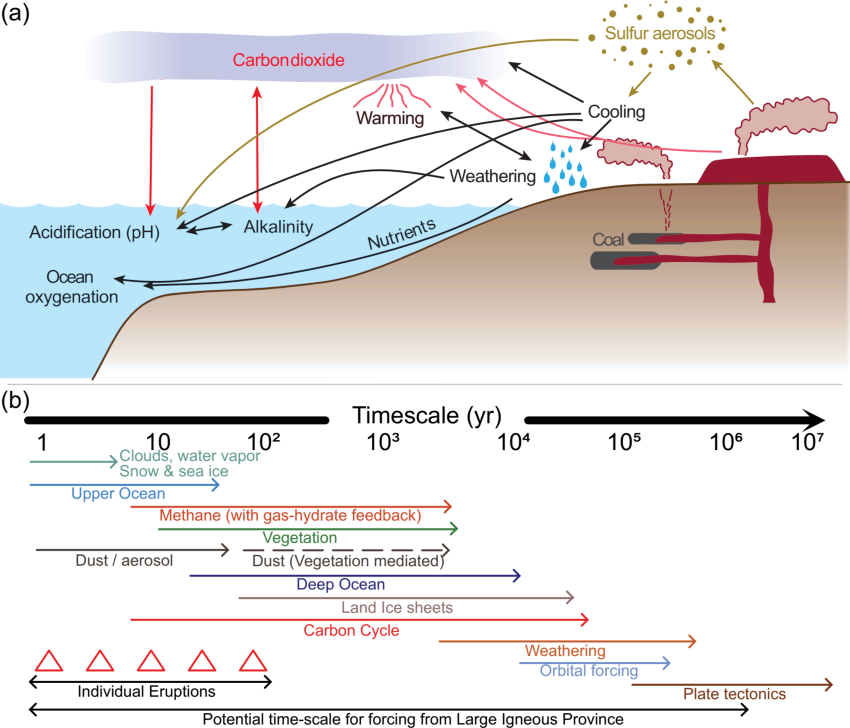
Figure 1. (a) A schematic illustration showing the direct and indirect environmental effects of volcanic carbon and sulfur emissions from Large Igneous Province (LIP) volcanism, modified after Clapham and Renne (2019). (b) Timescale of earth system processes and geological events affecting the surface environmental change. We note the potential timescales for forcings from individual eruptions and large igneous province emplacement at the bottom. Modified after Rohling et al. (2018).
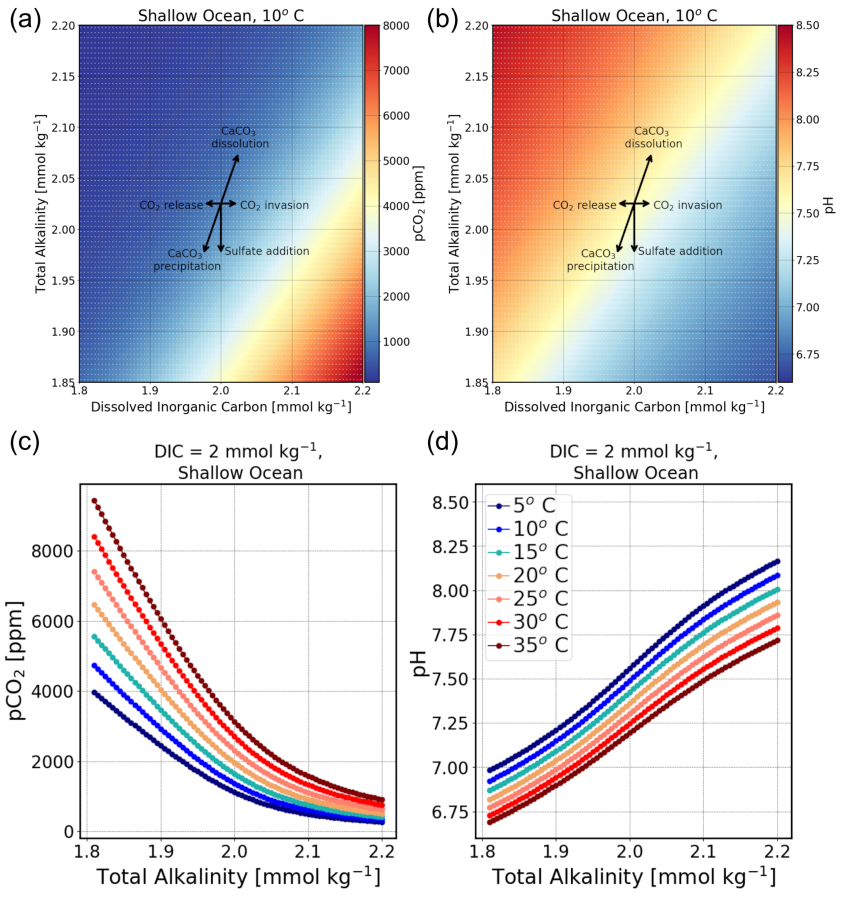
Figure 2. Alkalinity (TA) versus dissolved inorganic carbon (DIC) plots, calculated using CO2SYS, for the very shallow ocean (~100 m) and 10℃ with corresponding equilibrium values shown as colors for atmospheric pCO2 (a) and pH (b). Effects of seawater temperature on the equilibrium pCO2 (c) and pH (d) as a function of TA for a fixed DIC value (2 mmol/kg) and shallow ocean depths (~ 100 m).
Despite some recent studies focusing on aspects of this coupling (Black et al. 2018, Landwehrs et al., 2020; Hull et al., 2020; Cox and Keller, 2023), there is a clear knowledge gap in our mechanistic understanding of the combined effects of carbon and sulfur release over relevant timescales (sub-yr to 100s kyr), especially when considering different feedback loops in the marine carbon cycle system.
Our study uses a long-term marine carbon cycle box model LOSCAR (Long-term Ocean-atmosphere-Sediment CArbon cycle Reservoir Model; Zeebe, 2012) to test the hypothesis that volcanic sulfur can have a significant long-term effect on the marine carbon cycle (pH, alkalinity, and carbonate compensation depth) and that the effects of volcanic sulfur are not simply additive to the impact of volcanic carbon alone. By performing model runs with very fine temporal resolution (~0.1-year timestep), we analyze the effects of a single LIP eruption (i.e., a single lava flow-field, or gas emission event) as a source of CO2 and sulfate into the atmosphere (e.g., Self et al., 2014).
Methods:
In our analysis, we focus primarily on five marine environmental tracers: temperature, pH, total alkalinity (TA), dissolved inorganic carbon (DIC), and the carbonate compensation depth (CCD). These tracers were chosen because they have a significant influence on marine ecosystems and characterize the state of the marine carbonate system following volcanic eruptions (e.g., Hull et al., 2020; Landwehrs et al., 2020; Le Hir et al., 2020; Mather and Schmidt, 2021).
For this study, we utilized a geochemical intermediate complexity Earth System model, LOSCAR (Long-term Ocean-atmosphere-Sediment CArbon cycle Reservoir), which models carbon cycle perturbations in the oceans, atmosphere, and ocean sediments (Zeebe, 2012) with a multi-box setup (3 boxes each for each ocean basin along with high latitude and atmospheric boxes). To evaluate the effects of volcanic sulfur emissions on the ocean carbonate system, we modified the original LOSCAR model to include (a) atmospheric effects: sulfate aerosol-driven cooling based on radiative forcing, converted from SO2 emission flux, and (b) ocean chemistry effects: the effect of sulfur (SO42-) on ocean alkalinity (following Hull et al., 2020). In our simulations, we converted volcanic SO2 emissions (Tg/yr) into a global radiative forcing (W/m2) by parameterizing the global climate model results (with aerosol growth) from Schmidt et al. (2015). The volcanic sulfur emissions also result in a net decrease in TA through the addition of sulfate ions to the surface ocean boxes. We created a range of eruption scenarios by controlling two key parameters: (A) the mass eruption rate (km³/yr), which represents the volume of lava erupted per year, and (B) the duration of the eruption (years).
We also use pyCO2SYS (Xu et al., 2017; Humphreys et al., 2022); to calculate the equilibrium ocean carbonate chemistry for a range of TA-DIC-seawater temperature conditions for both the shallow and deep ocean. In Figure 2c and d, we show how the equilibrium pCO2 and pH change as a function of both TA and temperature (at a constant DIC of 2 mmol/kg). As expected, at higher TA, the equilibrium atmospheric pCO2 decreases, and the pH increases. However, seawater temperature strongly affects the exact value of both these tracers – increasing temperature from 5 to 35°C can lead to up to a 4000 ppm pCO2 increase and 0.4 unit pH decrease. Thus, ocean temperature changes due to volcanic carbon and sulfur emissions will have a significant but complex impact on the environmental tracers.
Results:
We find that the assumption that the effects of each type of gas are independent is not accurate. Instead, we show that the carbon-cycle effects (dissolved inorganic carbon, pH, alkalinity, and carbonate compensation depth) of sulfur emissions, in particular, can persist on long timescales (>1000 years) in addition to short-term cooling (Figure 3). This is due to two processes: the strongly temperature-dependent equilibrium coefficients for marine carbonate chemistry and the few thousand-year timescale for ocean overturning circulation. Thus, the effects of volcanic sulfur are not simply additive to the impact of carbon emissions.
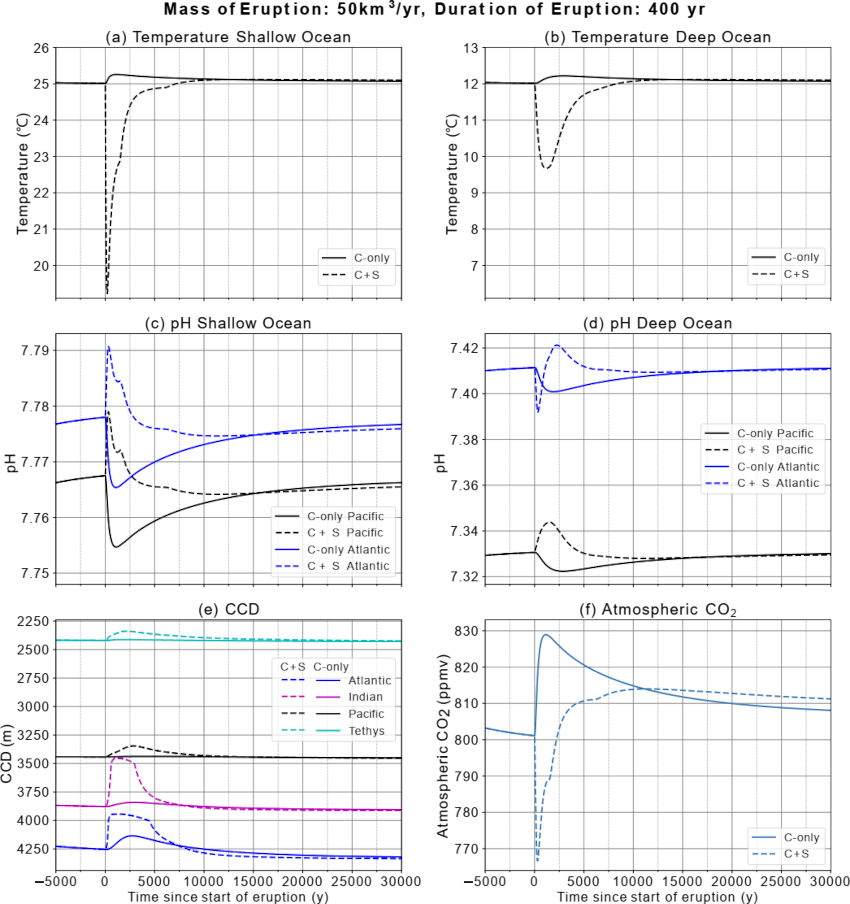
Figure 3. Plots of several environmental tracers responding to gas equivalents of an eruption of 50 km3/yr of basalt (with assumed gas content of 14 Tg/km3 of CO2 and 6 Tg/km3 of SO2), emitted over 400 years, for carbon-only (carbon-only, solid lines) and carbon + sulfur (C+S, dashed lines) model results. Each plot spans 5000 years before the eruption to 30,000 years since eruption initiation to highlight initial changes (c.f. the total model duration is 2,000,000 years). (a) and (b) show the temperature in the shallow and deep ocean, respectively (note these temperatures are the same for the major ocean basins and only vary as a function of ocean depth). (c) and (d) show pH for the Pacific and Atlantic oceans as representative examples. (e) shows the CCD response for each major ocean basin. (f) shows atmospheric pCO2 for the carbon-only and carbon + sulfur models.
In our carbon + sulfur model results, we find some counterintuitive behavior, such as the increase in pH in the surface ocean immediately following an eruption. However, the reason for this change became clear when considering the impact of temperature decrease on DIC species equilibria. In more detail, we find that the effects of cooling on temperature-dependent DIC-species equilibrium coefficients result in faster transport of atmospheric carbon into the ocean compared to the carbon-only model. Furthermore, the feedback described above leads to a rapid shoaling of the CCD and then a subsequent rebound in pH within a few hundred to a thousand years. Overall, the calcium carbonate dissolution feedback process, which occurs in the C-O model over 5,000‒20,000 years, occurs much more rapidly in the carbon + sulfur model.
Furthermore, because carbon is sequestered into the ocean faster in the carbon + sulfur model, the overall long-term warming is less, even long after the sulfate aerosol-driven cooling is over (Figure 4). This is because the peak atmospheric carbon dioxide is lower in the carbon + sulfur model due to the rapid sequestration of some volcanic carbon in the ocean compared to the carbon-only model. Thus, even with the same total volcanic carbon emissions, the climate response of the carbon + sulfur model is strikingly different. This result contrasts with previous studies, (e.g., Hull et al., 2020), that only considered the effects of sulfur on ocean alkalinity and hence found that volcanic sulfur caused enhanced warming over long timescales. Overall, our results illustrate that the timescale separation assumption for volcanic carbon and sulfur impacts, inherent in a number of previous studies, does not always apply. Based on a parameter sensitivity analysis, we find that both the eruption rate and duration are important, depending on the environmental tracer of interest, and eruption volume alone does not capture the full carbon cycle response (Figure 5).
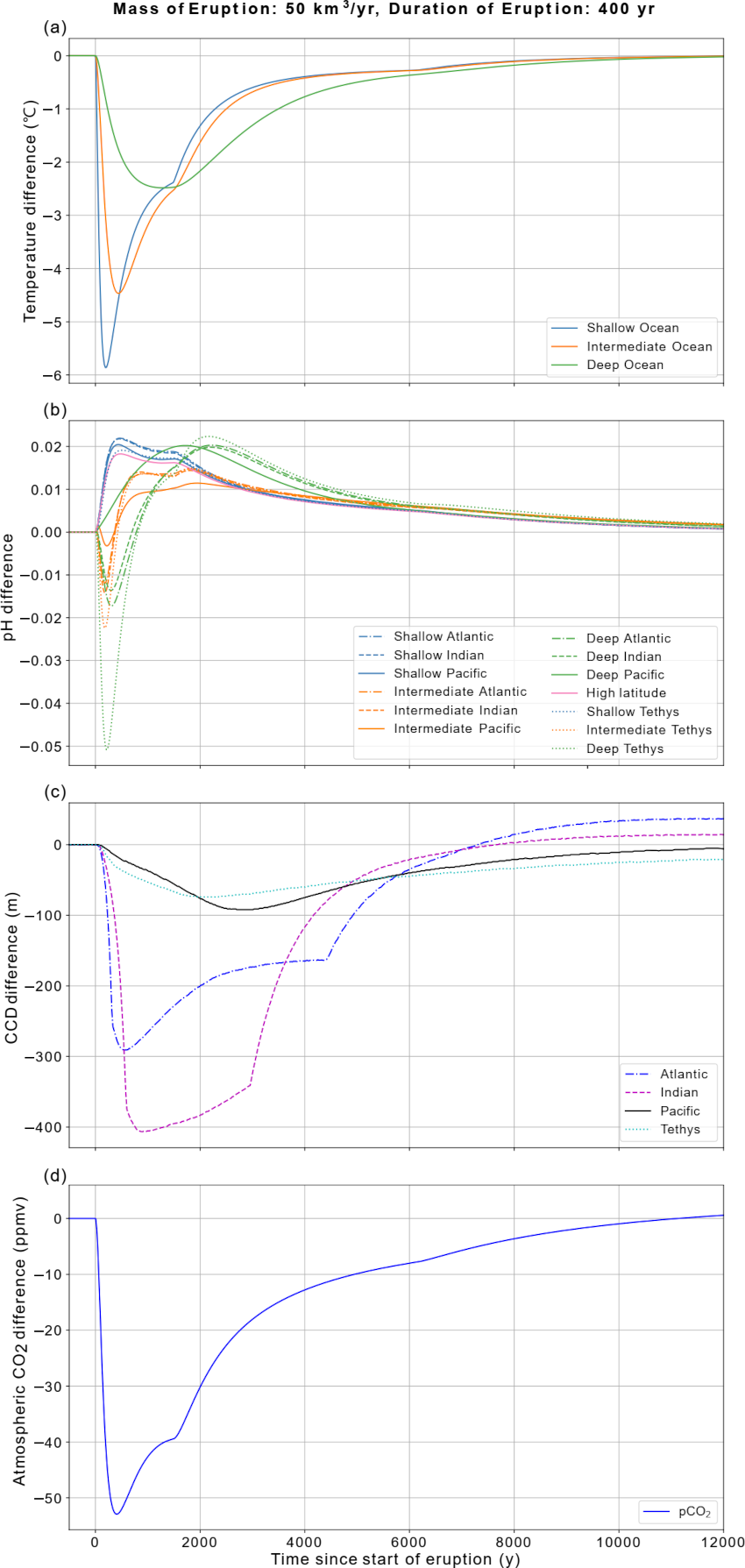
Figure 4. Differences in temperature (a), pH (b), CCD (c), and atmospheric pCO2 (d) between the combined carbon and sulfur (C+S) model and the carbon-only (C-only) model for an eruption of 50 km3/yr and duration of 400 years. The plots are illustrated by subtracting the value for the relevant parameter in the C-only model results from the C+S model results. Hence, negative (positive) values indicate lower (higher) environmental tracer values in the combined model than in the carbon-only model.
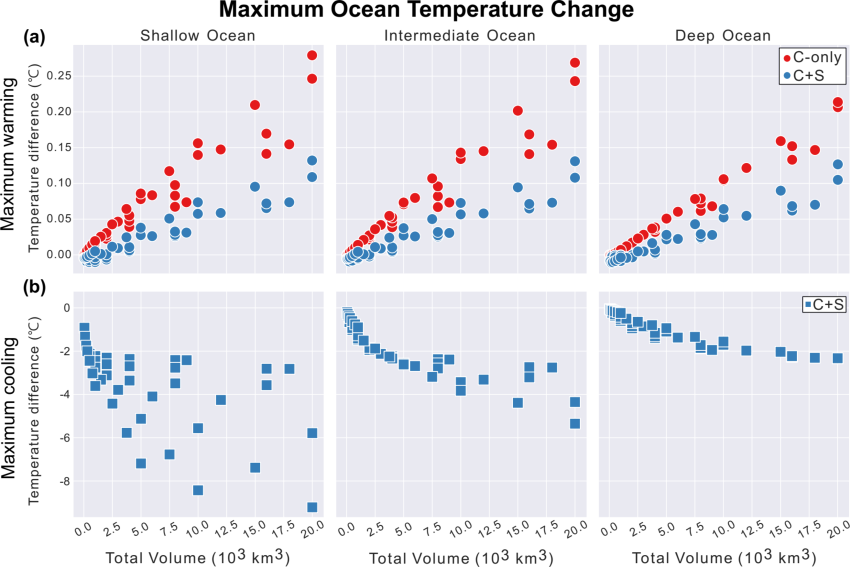
Figure 5. Plots of maximum warming and maximum cooling in relation to the total volume of the eruption (km3). Note the difference in the y-axis scale for (a) and (b) and that the temperatures are the same for the major ocean basins and only vary as a function of ocean depth. Maximum warming (cooling) is the maximum difference between the initial and highest (lowest) temperature values for a particular model result (C-only: red circles; C+S: blue circles and squares). Maximum cooling is not plotted for the C-only model because cooling effects are insignificant.
To visualize the various non-intuitive feedbacks and isolate the dominant effects and the associated timescales, we generate a causal diagram to illustrate step-by-step how volcanic gases affect the ocean-atmosphere system (Figure 6). The causal diagram has two causal sequences for CO2 and SO2, respectively. Both start with temperature changes and are followed by interlinked changes in marine chemistry, atmospheric pCO2, and temperature on various timescales. The causal diagram illustrates that volcanic sulfur has a significant impact on many key environmental tracers - temperature, pH, TA, DIC, and CCD. We also find that the relevant timescales for many processes are ~centuries. Thus, carbon cycle models with a few 1000-year time steps (e.g., Cox and Keller, 2023) will not resolve these processes, and this may strongly affect the long-term behavior. In the future, this causal framework can be extended to include physical (atmospheric, ocean dynamics) and biological processes to help develop a comprehensive understanding of how large volcanic eruptions affect the environment.
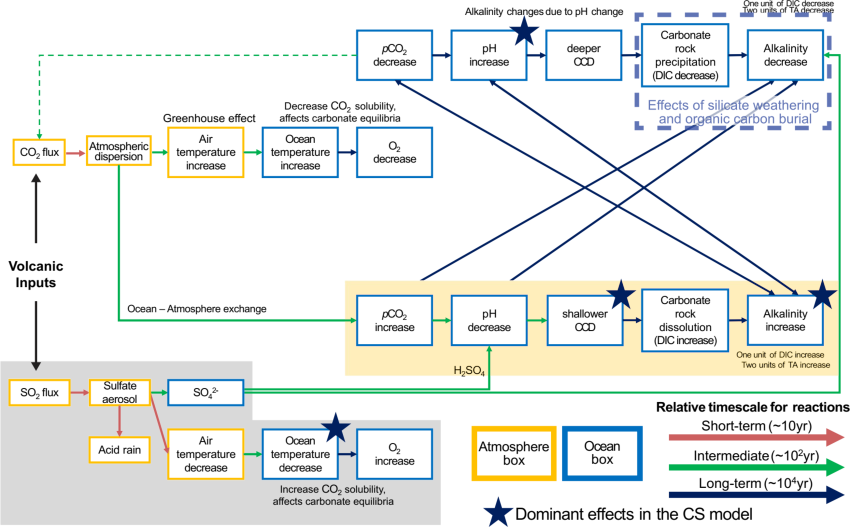
Figure 6. Causal diagram showing the dominant effects and relative reaction rate from LOSCAR model results. The red arrows indicate short-term processes (~tens of years), the green arrows intermediate (~hundreds of years), and the dark blue arrows indicate long-term processes (~thousands of years). Blue stars highlight the dominant effects in the model results. Temperature decrease, pH increase, and TA increase are the dominant environmental effects of the combined sulfur and carbon model. The yellow highlighted box shows the dominant reaction flow in the model results.
Overall, our results help develop a better mechanistic understanding of how LIP volcanism affects the global climate – validating our hypothesis that volcanic sulfur emissions can have a significant long-term effect on the marine carbon cycle (pH, alkalinity, and carbonate compensation depth) and not just on short (tens to hundreds of years) timescales. The effects of volcanic sulfur are not simply additive to the impact of volcanic carbon alone, highlighting the importance of analyzing them both jointly, rather than individually, for large eruptions, particularly flood basalt eruptions. In our ongoing work, we are extending the analysis from a single eruption to a sequence of eruptions closely spaced in time, more akin to an LIP volcanic sequence. Our findings in this study have important implications for interpreting paleoclimate proxies, especially high-resolution records of potential LIP-associated cooling and warming (e.g., O’Connor et al., 2024).
References
Berner, R. A., & Caldeira, K. (1997). The need for mass balance and feedback in the geochemical carbon cycle. Geology, 25(10), 955-956. https://doi.org/10.1130/0091-7613(1997)025<0955:TNFMBA>2.3.CO;2
Black, B. A., Neely, R. R., Lamarque, J.-F., Elkins-Tanton, L. T., Kiehl, J. T., Shields, C. A., et al. (2018). Systemic swings in end-Permian climate from Siberian Traps carbon and sulfur outgassing. Nature Geoscience, 11(12), 949-954. https://doi.org/10.1038/s41561-018-0261-y
Black, B. A., Karlstrom, L., & Mather, T. A. (2021). The life cycle of large igneous provinces. Nature Reviews Earth & Environment, 2(12), 840-857. https://doi.org/10.1038/s43017-021-00221-4
Bogumil, M., Mittal, T., & Lithgow-Bertelloni, C. (2024). The effects of bathymetry on the long-term carbon cycle and CCD. Proceedings of the National Academy of Sciences, 121(21), e2400232121. https://doi.org/10.1073/pnas.2400232121
Callegaro, S., Baker, D. R., Renne, P. R., Melluso, L., Geraki, K., Whitehouse, M. J., et al. (2023). Recurring volcanic winters during the latest Cretaceous: Sulfur and fluorine budgets of Deccan Traps lavas. Science advances, 9(40), eadg8284. https://doi.org/10.1126/sciadv.adg8284
Clapham, M. E., & Renne, P. R. (2019). Flood basalts and mass extinctions. Annual Review of Earth and Planetary Sciences, 47(1), 275-303. https://doi.org/10.1146/annurev-earth-053018-060136
Cox, A. A., & Keller, C. B. (2023). A Bayesian inversion for emissions and export productivity across the end-Cretaceous boundary. Science, 381(6665), 1446-1451. https://doi.org/10.1126/science.adh3875
Ernst, R. E. (2014). Large igneous provinces: Cambridge University Press. https://doi.org/10.1017/CBO9781139025300
Hull, P. M., Bornemann, A., Penman, D. E., Henehan, M. J., Norris, R. D., Wilson, P. A., et al. (2020). On impact and volcanism across the Cretaceous-Paleogene boundary. Science, 367(6475), 266-272. https://doi.org/10.1126/science.aay5055
Humphreys, M. P., Lewis, E. R., Sharp, J. D., & Pierrot, D. (2022). pyCO2SYS v1. 8: Marine carbonate system calculations in Python. Geoscientific Model Development, 15(1), 15-43. https://doi.org/10.5194/gmd-15-15-2022
Kasbohm, J., Schoene, B., & Burgess, S. (2021). Radiometric constraints on the timing, tempo, and effects of large igneous province emplacement. Large igneous provinces: A driver of global environmental and biotic changes, 27-82. https://doi.org/10.1002/9781119507444.ch2
Landwehrs, J. P., Feulner, G., Hofmann, M., & Petri, S. (2020). Climatic fluctuations modeled for carbon and sulfur emissions from end-Triassic volcanism. Earth and Planetary Science Letters, 537, 116174. https://doi.org/10.1016/j.epsl.2020.116174
Le Hir, G., Fluteau, F., Suchéras-Marx, B., & Goddéris, Y. (2020). Amplifying factors leading to the collapse of primary producers during the Chicxulub impact and Deccan Traps eruptions. Mass Extinctions, Volcanism, and Impacts: New Developments, 544, 223. https://doi.org/10.1130/2020.2544(09)
Mather, T. A., & Schmidt, A. (2021). Environmental effects of volcanic volatile fluxes from subaerial large igneous provinces. Large igneous provinces: A driver of global environmental and biotic changes, 103-116. https://doi.org/10.1002/9781119507444.ch4
Mittal, T., Richards, M. A., & Fendley, I. M. (2021). The magmatic architecture of continental flood basalts I: Observations from the Deccan Traps. Journal of Geophysical Research: Solid Earth, 126(12), e2021JB021808. https://doi.org/10.1029/2021JB021808
O’Connor, Lauren K., Rhodri M. Jerrett, Gregory D. Price, Tyler R. Lyson, Sabine K. Lengger, Francien Peterse, and Bart E. van Dongen. "Terrestrial evidence forvolcanogenic sulfate-driven cooling event~ 30 kyr before the Cretaceous–Paleogene mass extinction." Science advances 10, no. 51 (2024): eado5478.
Penman, D. E., Rugenstein, J. K. C., Ibarra, D. E., & Winnick, M. J. (2020). Silicate weathering as a feedback and forcing in Earth's climate and carbon cycle. Earth-Science Reviews, 209, 103298. https://doi.org/10.1016/j.earscirev.2020.103298
Rohling, E. J., Marino, G., Foster, G. L., Goodwin, P. A., Von der Heydt, A. S., & Köhler, P. (2018). Comparing climate sensitivity, past and present. Annual Review of Marine Science, 10(1), 261-288. https://doi.org/10.1146/annurev-marine-121916-063242
Schmidt, A., Skeffington, R. A., Thordarson, T., Self, S., Forster, P. M., Rap, A., et al. (2016). Selective environmental stress from sulphur emitted by continental flood basalt eruptions. Nature Geoscience, 9(1), 77-82. https://doi.org/10.1038/ngeo2588
Self, S., Schmidt, A., & Mather, T. (2014). Emplacement characteristics, time scales, and volcanic gas release rates of continental flood basalt eruptions on Earth. Geological Society of America Special Papers, 505, 319-337. https://doi.org/10.1130/2014.2505(16)
Tosca, N. J., & Tutolo, B. M. (2023). Alkalinity in theory and practice. Elements, 19(1), 7-9. https://doi.org/10.2138/gselements.19.1.7
Xu, Y.-Y., Pierrot, D., & Cai, W.-J. (2017). Ocean carbonate system computation for anoxic waters using an updated CO2SYS program. Marine Chemistry, 195, 90-93. https://doi.org/10.1016/j.marchem.2017.07.002
Zeebe, R. E. (2012). LOSCAR: Long-term ocean-atmosphere-sediment carbon cycle reservoir model v2. 0.4. Geoscientific Model Development, 5(1), 149. https://doi.org/10.5194/gmd-5-149-2012
